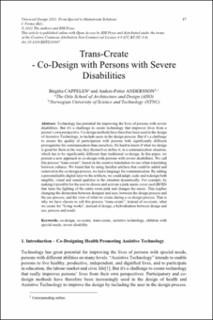| dc.contributor.author | Cappelen, Birgitta | |
| dc.contributor.author | Andersson, Anders-Petter | |
| dc.date.accessioned | 2021-09-23T07:11:56Z | |
| dc.date.available | 2021-09-23T07:11:56Z | |
| dc.date.created | 2021-06-23T14:30:57Z | |
| dc.date.issued | 2021 | |
| dc.identifier.isbn | 978-1-64368-190-0 | |
| dc.identifier.uri | https://hdl.handle.net/11250/2780642 | |
| dc.description.abstract | Technology has potential for improving the lives of persons with severe disabilities. But it's a challenge to create technology that improves lives from a person’s own perspective. Co-design methods have therefore been used in the design of Assistive Technology, to include users in the design process. But it’s a challenge to ensure the quality of participation with persons with significantly different prerequisites for communication than ourselves. It's hard to know if what we design is good for them in the way they themselves define it, in a communication situation, which has to be significantly different than traditional co-design. In this paper, we present a new approach to co-design with persons with severe disabilities. We call this process “trans-create”, based on the creative translation we use when translating between cultures. We found that by using familiar artifacts that could be added and removed in the co-design process, we had a language for communication. By adding a personalisable digital layer to the artifacts, we could adapt, scale and redesign both tangible, visual and sound qualities in the situation dynamically. For example, by making it possible for the user to choose and activate a pink music cover card (RFID) that turns the lighting of the entire room pink and changes the music. This implies changing the distinction between designer and user, between the design process and the use process, and the view of what we create during a co-design process. That is why we have chosen to call this process “trans-create”, instead of co-create, what we create for “living works”, instead of design, a hybridisation between design and use, process and result. | en_US |
| dc.language.iso | eng | en_US |
| dc.publisher | IOS | en_US |
| dc.relation.ispartof | Universal Design 2021: From Special to Mainstream Solutions | |
| dc.relation.ispartofseries | Studies in Health Technology and Informatics; | |
| dc.relation.uri | https://ebooks.iospress.nl/volumearticle/57124 | |
| dc.rights | Attribution-NonCommercial-NoDerivatives 4.0 Internasjonal | * |
| dc.rights.uri | http://creativecommons.org/licenses/by-nc-nd/4.0/deed.no | * |
| dc.subject | Brukermedvirkning i design | en_US |
| dc.subject | Participatory Design | en_US |
| dc.subject | Assitive technology | en_US |
| dc.subject | Assistive technology | en_US |
| dc.subject | Universell utforming av IKT | en_US |
| dc.subject | Universal design of ICT | en_US |
| dc.subject | Taktile medier | en_US |
| dc.subject | Tangible interaction | en_US |
| dc.title | Trans-Create – Co-Design with Persons with Severe Disabilities | en_US |
| dc.type | Chapter | en_US |
| dc.description.version | publishedVersion | en_US |
| dc.subject.nsi | VDP::Arkitektur og design: 140 | en_US |
| dc.subject.nsi | VDP::Architecture and design: 140 | en_US |
| dc.source.pagenumber | 87-101 | en_US |
| dc.source.volume | Volume 282: Universal Design 2021: From Special to Mainstream Solutions | en_US |
| dc.identifier.doi | 10.3233/SHTI210387 | |
| dc.identifier.cristin | 1917975 | |
| cristin.ispublished | true | |
| cristin.fulltext | original | |
| cristin.qualitycode | 1 | |

